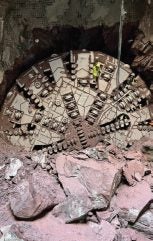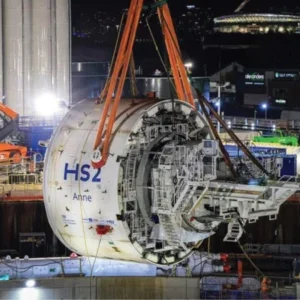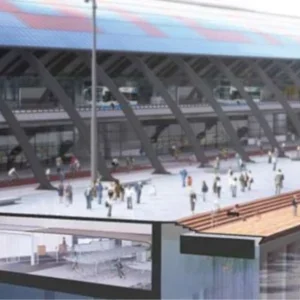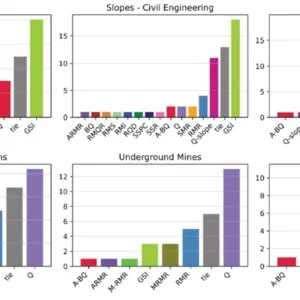
The Narragansett Bay Commission (NBC) has completed the excavation of the 3.5km-long Pawtucket Tunnel, the centerpiece of Phase III of its Combined Sewer Overflow (CSO) Abatement Programme in Rhode Island. Phases 1& II were focused on the Providence area and completed in 2008.
Pawtucket Tunnel is located near the Seekonk and Blackstone Rivers in Pawtucket, and is Phase IIIA of the CSO project. The project criteria is to provide a storage capacity of 58.5 MG during the 3-month design flow. The project includes an 24.4m i.d. pump station shaft. Hydraulic criteria for the project specified use of vortexstyle drop shafts (4No) able to convey peak flows from the 2-year storm.
The tunnel alignment runs 35m to 47m below the ground surface through complex geology, originating from fluvial deposits and predominantly consisting of sandstone and siltstone with some conglomerate and coal. The ground has structural features including folds, faults, and joints.
The project was in planning and development since 2014 and was awarded as a Design Build contract (see box panel). Minimum rock cover is two tunnel diameters. A supplementary geotechnical investigation plan was developed.
As the plans and design progressed, changes included during the contract raised the elevation by 7.6m (during the Alternative Technical Concept process) to decrease the overall profile in rock; relocated the pump station away from a fault/shear zone; and, incorporated temporary support structures in the permanent design.
The 9.1m i.d. tunnel lining was erected by TBM and has universal double taper rings (seven segments, of fibre reinforced concrete ”(FRC)), 350mm-thick and 2m-long. Each segment joint, both radial and circumferential, is fully gasketed to achieve the water tightness criteria (Maximum allowable groundwater infiltration 1 gpm per 305m of tunnel and 0.1 gpm at any one segment).
GEOLOGY
The geologic history of the bedrock is complex. The rock originates from fluvial deposits, which characteristically are not laterally continuous. Sequential episodes of tectonic deformation have superimposed structural features including folds, faults, and joints.
The Pawtucket Tunnel is constructed mainly in the Rhode Island Formation, a Carboniferous-age sedimentary rock comprised of sandstone and siltstone, with lesser amounts of conglomerate, shale, and coaly deposits. Bedrock is moderately folded and faulted. Bedrock is overlain by a thin layer of glacial till and thick layers of glaciofluvial deposits. Glacial deposits are comprised mainly of sand, gravel, and silt, and are overlain by granular fill.
The project area is within the Narragansett Basin, which is approximately 86km-long, and 24km to 40km in width, and is made up of several thousand feet of non-marine sedimentary rocks that have been folded, faulted, and slightly to moderately metamorphosed. Sedimentary rocks of the Narragansett Basin have been divided into five formations, of which the Wamsutta Formation and the Rhode Island Formation occur within the tunnel horizon. Bedrock is overlain by glacial deposits consisting of till and glaciofluvial deposits as well as man-made fill deposits near surface.
The Rhode Island Formation is widespread and consists mainly of grey sandstone and siltstone, with lesser amounts of grey to black shale, conglomerate, and coaly rock. These sediments were deposited in medial to distal alluvial fan environments, and are comprised of meandering stream deposits, bank and flood plain deposits, and swamp deposits. Sediments of the Rhode Island Formation generally are finer-grained than those of the Wamsutta Formation. Rock types are laterally and vertically discontinuous, a characteristic of the environment in which they formed.
The Wamsutta Formation occurs in the northern part of the Narragansett Basin, where it underlies and partially interfingers with the Rhode Island Formation (Skehan, Rast, and Mosher 1986). The Wamsutta Formation consists of a sequence of red conglomerates, sandstones, and shales up to 915m thick. Volcanic fragments are common. Conglomerate in the Pawtucket quadrangle contains boulders as large as 1.2m wide (Quinn 1971). These sediments were deposited in an alluvial fan environment, and are composed of braided stream deposits, with related crevasse splay deposits and flood plain deposits. Bedrock of the Wamsutta Formation is present along the northern 61m to 122m of the tunnel.
TUNNELLING
Notice-to-proceed with the Design-Build contract was issued at the end of 2020, triggering the TBM contract.
The tunnel was mined with a Herrenknecht dual mode (open/earth pressure balance (EPB)) machine fitted with a hard rock, 10.3m diameter cutterhead having 64 x 480mm discs. The TBM used a conveyor in open mode, and screw conveyor in EPB mode. The structure and seals are designed for 5 bar of pressure, and minimum required curvature was 305m for the 14m-long shield. The TBM had 91m-long trailing gear, comprised of four backup gantries.
The Factory Acceptance Test (FAT) was completed ahead of schedule in January 2022, and shipment delivery was April-June.
The TBM began mining in November 2022, from the launch shaft on the main site at the Southern end of the project area.
Project challenges included: labour and material cost escalations with supply chain disruptions during the pandemic; finding a home for the approximately 1,000,000 tonnes of excavated tunnel material; and pre-treatment of significant flow from excavation dewatering (ranging from 50,000 gallons per day to 120,000 gallons per day). The project parties collaborated to negotiate equitable sharing of escalated costs; beneficial re-use of more than half of the excavated tunnel material; and, adequate handling and pre-treatment of dewatering flows.
TBM breakthrough was mid-February 2024 at the receiving shaft. The entire tunnel was mined in open mode, the ground conditions not requiring the use of EPB mode.
The project is to be substantially complete at the end of this year.
PROJECT PARTIES
List of the principal parties on the Pawtucket Tunnel project.
Project Owner: Narragansett Bay Commission (NBC).
Lead designer, programme and construction manager: Stantec, with Pare Corporation, for the Phase III programme.
Design Build Contractor: CB3A, a joint venture of CBNA, a U.S.-based subsidiary of French construction engineering firm Bouygues Travaux Publics, and local civil works contractor Barletta Heavy Division. Contractor’s prime engineer/designer: AECOM, and is Engineer of Record, with oversight of four sub-consultants (GEI, BETA, Gall Zeidler, and Mueser Rutledge)
Timeline: Planning and alignment alternatives studies for Pawtucket Tunnel began in 2014. In 2019, NBC had industry outreach talks with contractors, then selected a Design Build delivery method to meet the regulatory project schedule and manage risk. Procurement was a two-step process: in 2019, Request for Qualification (RFQ); and, in 2020, the Request for Proposals (RFP) to short-listed firms to submit bids. The pandemic period of restrictions led to challenges for all. Contract award in late 2020. Construction started in Spring 2021, tunnelling in late 2022. With the tunnelling success, project completion is anticipated to be end of 2024.






